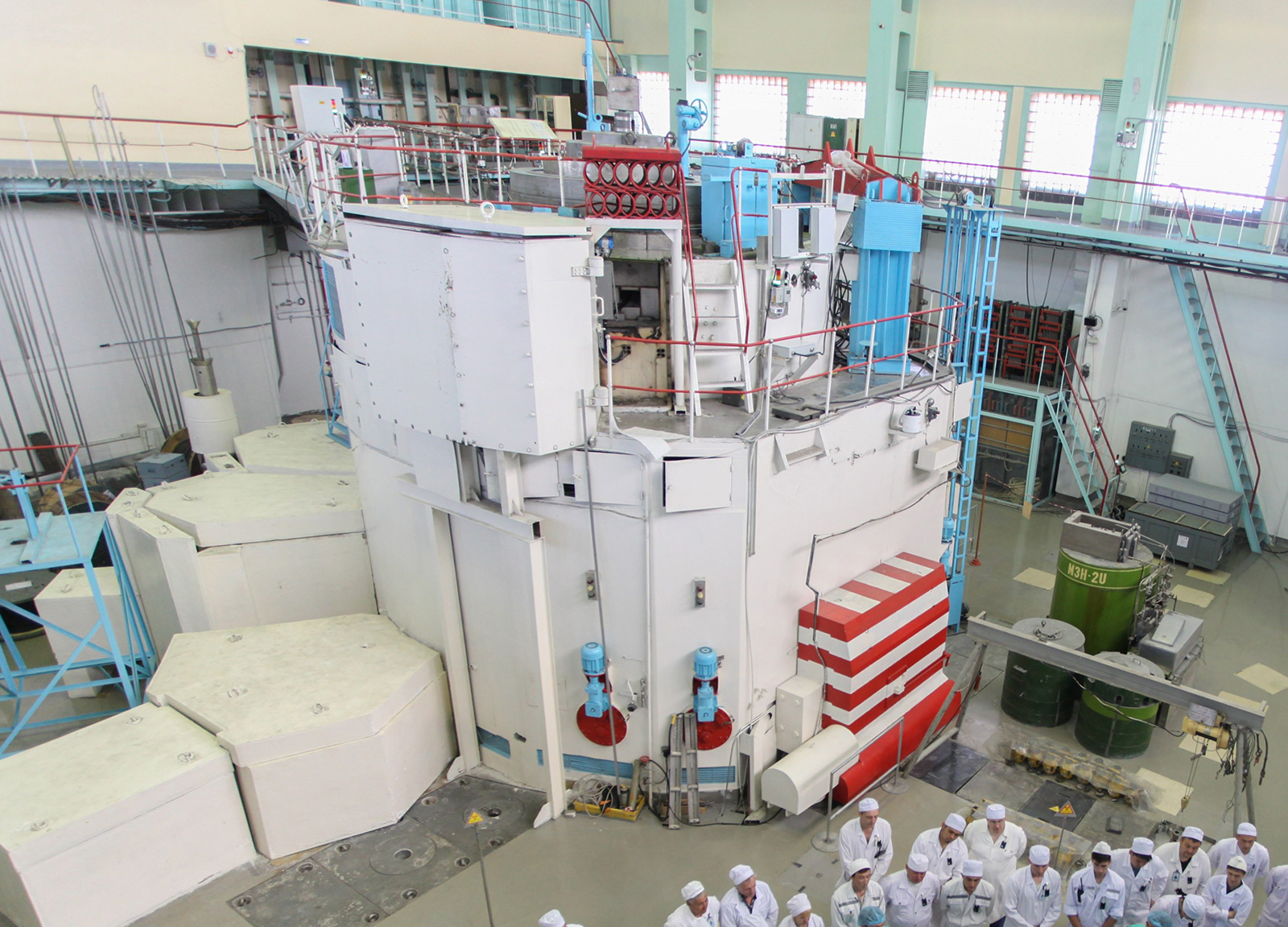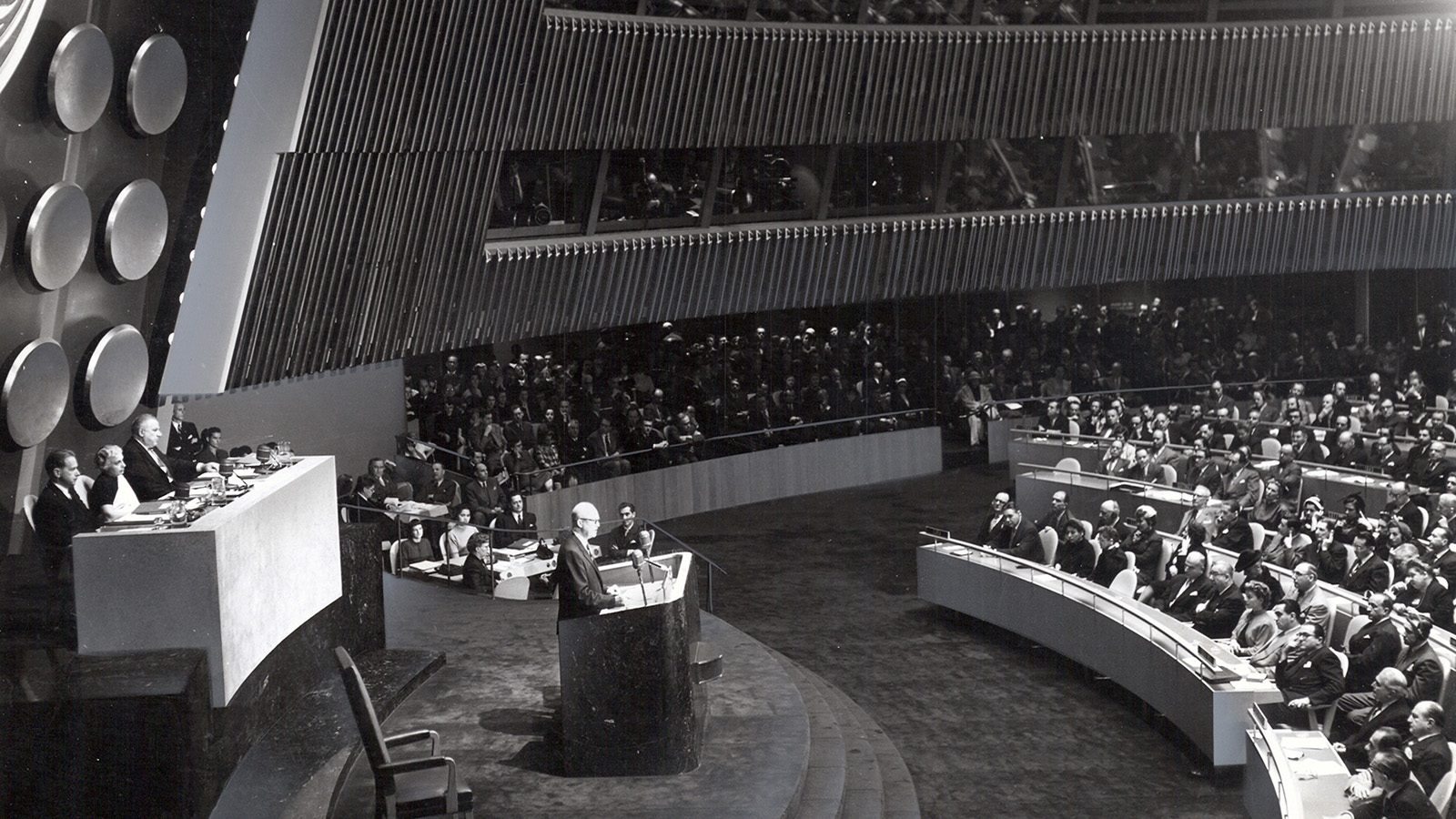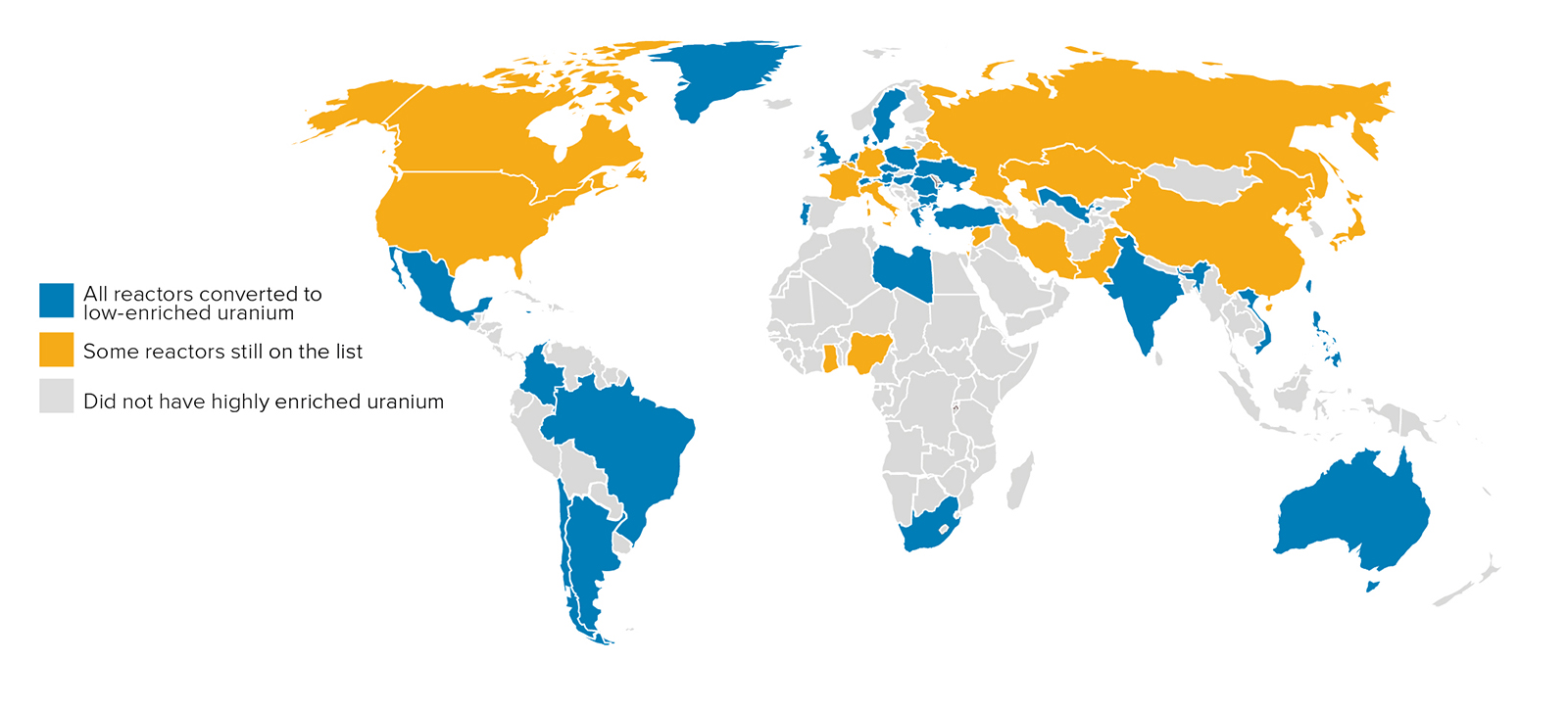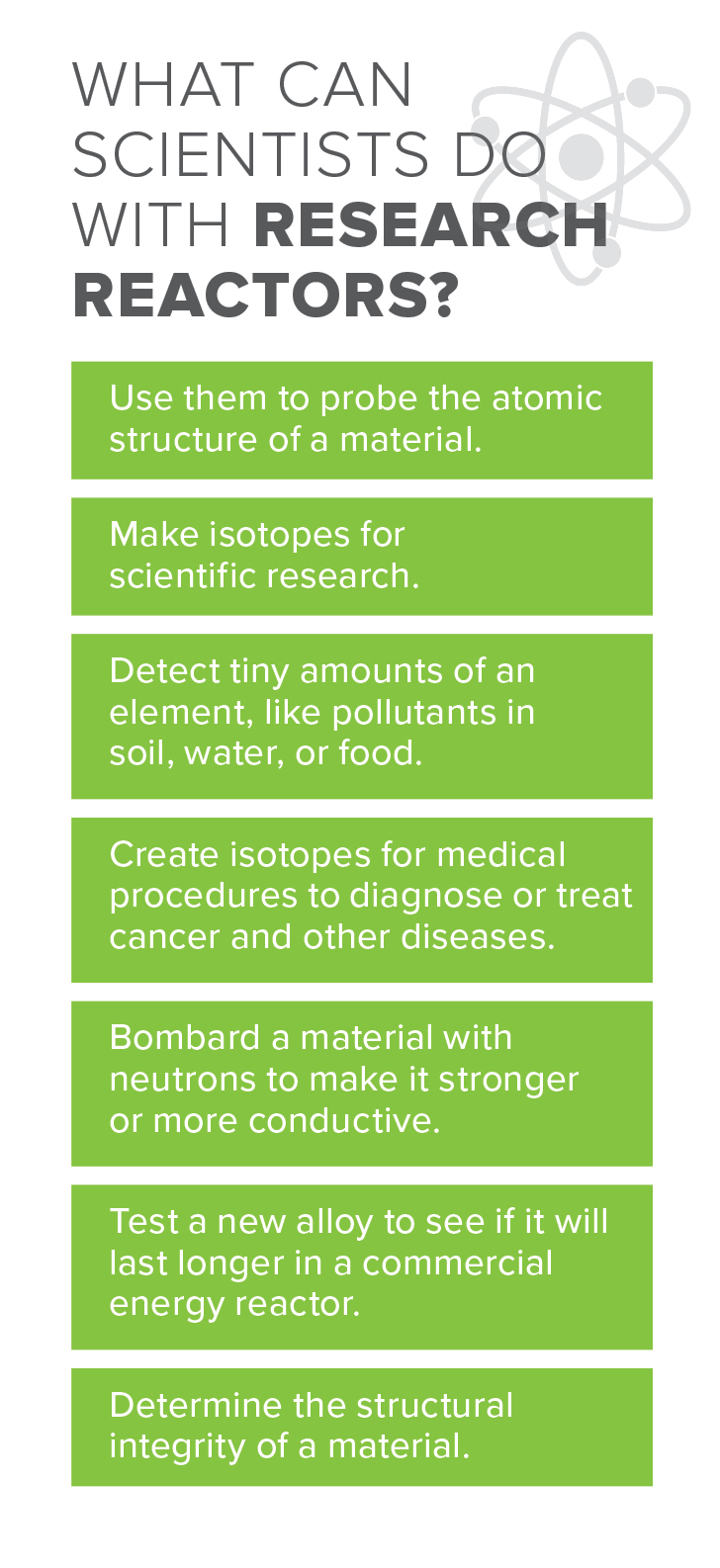
In Almaty, Kazakhstan, in the foothills of the Tian Shan mountain range, there is a small nuclear research reactor that has been running for half a century. It doesn’t look like the nuclear energy plants that provide a fifth of the electricity in neighboring Russia. Instead of electricity, this reactor churns out neutrons for scientific research and isotopes for medicine—and it has been doing so using a highly controlled substance.
Until last year, the Almaty plant ran on highly enriched uranium fuel, which has been processed to contain a lot of one particular uranium isotope that is very easy to split. This makes the fuel a powerful tool for scientific research. But it also makes it easier to use to make nuclear weapons.
The world is dotted with similar reactors, fueled by uranium from the U.S., Russia, and later China, in a decades-long push to export nuclear technology for scientific study. The three nations helped build reactors in more than three dozen countries—such as Kazakhstan, Brazil, Jamaica, Ghana, Denmark, and Vietnam—and most of these reactors are still running.
For nearly four decades, scientists and engineers at Argonne National Laboratory have been leading the global effort to convert these reactors to run on low-enriched uranium instead. In Almaty, these scientists worked with the Kazakhs on a decade-long conversion of this particular reactor, called VVR-K. Earlier this year, Argonne staff traveled to Almaty to watch VVR-K become the 69th reactor they have converted.
The goal is to reduce the amount of highly enriched uranium circulating in the world, to lower the risk that it might be stolen or diverted as it is manufactured, shipped, used, and then finally sent for disposal. To do this, the Argonne team, part of a U.S. Department of Energy program called Material Management and Minimization (M3 for short), works to redesign these reactors so that they can run on low-enriched uranium, which is much harder to make into weapons. Like converting a car engine to run on diesel instead of gasoline, the conversion takes a great deal of careful engineering— as well as diplomacy, knowledge, experience, and a little bit of luck.
IN DECEMBER OF 1953, President Eisenhower told the United Nations that the U.S., in a reversal from the absolute secrecy it had enforced around nuclear technology following the Manhattan Project, would instead share its research with scientists around the world who wished to use it for peaceful purposes.
From this “Atoms for Peace” speech sprang the research reactors: hundreds of them, designed and built with uranium and expertise from the U.S., and later Russia and China, and scattered around the world’s universities and scientific institutions.
Why did scientists want them? The atoms in nuclear fuel are very heavy and unstable. Researchers like them because they shoot off particles called neutrons, which can be used for many types of science and engineering. You can use neutrons to look deep inside objects; to process materials to give them new properties, such as making silicon more conductive; and to make isotopes for medicine, such as technetium-99, which is used around the world in tens of millions of medical procedures every year. You can also use these atoms to make isotopes to track molecules as they move through complicated biological processes.
The U.S. government began shipping radioisotopes to scientists from its reactors right after World War II. In the first decade of this program, those isotopes contributed to more than 10,000 published studies. We owe a significant chunk of today’s body of scientific knowledge to radioisotopes, including how cells make DNA, how our metabolism works, and how nutrients move through an environment.
So when the opportunity was offered, researchers around the world jumped at the chance to have their own research reactors.
This wide variety of purposes meant the reactors were all built a little differently, according to what scientists in each place wanted to use them for. Kazakhstan has three such research reactors, and each one has a fuel setup that’s completely different from the others.
So when it’s time to switch the reactors to low-enriched uranium, Argonne nuclear engineers have to solve several problems at once. They must redesign the core so that it fits in the same space while offering the same range of scientific capabilities, but uses a lower proportion of that easily splittable uranium isotope, U-235. And this is often all in a totally different setup from any reactor they’ve previously converted.
The task is not an easy one. But that’s why Argonne researchers wanted it.
“I really fell in love with the work— how each one is its own unique challenge,” said John Stevens, a nuclear engineer who runs the M3 program at Argonne. (Before this, he worked in the power industry for 20 years. Most reactors that produce power are very similar to one another.)
“Each one is different, but I like the hard ones. It keeps it interesting,” agreed Patrick Garner, a nuclear engineer who has done safety calculations for M3 for the last 15 years.
HERE IS HOW YOU CONVERT A REACTOR.
First, you talk with the scientists who use this reactor, which in this case is run by the Kazakh Institute of Nuclear Physics. You ask questions such as: How often do they change the fuel? What specific scientific applications do they use it for? What operating temperatures does it run at? This helps you design a new configuration for the reactor core.
In VVR-K’s case, the fuel design changed quite a bit, said Jordi Roglans-Ribas, who runs the nuclear engineering division at Argonne. He’s worked on the VVR-K conversion with his Kazakh counterpart, Petr Chakrov, since the conversion project began. The institute selected a new core design: eight concentric hexagonal tubes, instead of five. Water flows between the tubes to cool the reactor. “Because the spacing changes, the cooling properties change,” Roglans-Ribas said.
Simulations with powerful computers help provide data to assure the safety and reliability of the new configuration. You also need to make sure there’s a company willing to manufacture that fuel.
The whole time, you’re working with the scientists at the home institute. “They do the analysis. It has to be their reactor,” Garner said. “We provide training and do an independent set of backup calculations. We’re the extra set of eyes.”
The next step is to build test fuel and run experiments on it. This gives scientists at the foreign institution and the officials in that country’s nuclear regulatory agency lots of information to make their decisions. VVR-K’s test fuel spent 2 ½ years being irradiated before the team concluded it was up to speed, Garner said.
At this point, you remove the highly enriched uranium that was already in your reactor core, making arrangements to ship it for recycling and disposal. Leftover unused fuel can be “down-blended,” which means it’s mixed with freshly mined natural uranium to make low-enriched fuel. Next, make any necessary changes to fit the new core design into the old. Then do more tests. Sometimes the new core requires additional changes, or perhaps the home institute wants to take this opportunity to update the control room or other parts of the facility with the latest technology—for example, the new core design in VVR-K needed an upgrade to the control system. VVR-K is moving to dual analog and digital systems that are faster and more reliable, said Argonne mechanical engineer Hual-Te Chien; sensor technology has improved significantly in the past 40 years, he explained.
Other safety upgrades took advantage of new data on how to keep reactors safe in seismic zones. The large, beautiful mountains to the south of Almaty look calm, but may not always be.
Then, finally, your core is ready to be loaded with fresh, low-enriched uranium and tested.
THE INITIATIVE TO CONVERT the world’s research reactors dates back to 1978. John Glenn, the astronaut and later senator, was an early supporter. Argonne’s history of reactor design—most operating nuclear reactors around the world have some common roots in Argonne research—and the lab’s depth of nuclear engineering expertise made it a natural fit for the program.
Early on, the Argonne team designed a replacement fuel that is now the international standard for many such reactors. The first two reactors they converted, as demonstrations, were at the University of Michigan in 1981 and at Oak Ridge National Laboratory in 1986. Then they converted several foreign reactors, in Argentina, Austria, and Denmark, and moved on to reactors around the world.
In 2004, new agreements opened up pathways to several reactors the group had been eyeing for decades. The program completed 12 conversions in eight countries over the next four years, and it’s completed 18 conversions in 13 countries since then.
“Our goal is to be ready on the technical side when the political moment comes,” Stevens said.
In the last fiscal year, the Argonne team actively worked on 27 reactor conversion projects in 11 countries, including the U.S., he said.
The background work is substantial. More than two dozen scientists and engineers in Argonne’s nuclear engineering division work on conversions, and they can tap dozens of experts in other areas around the lab if they have a specific question.
Once the Energy Department and the State Department have secured an agreement with a country and the conversion begins in earnest, “we visit about four or five times per year,” Garner said. “There are some things you just need to sit down with people at the same table to work out.”
In most places they have to hire an interpreter who they try to hang on to across visits, because even native speakers may not know all the words in both languages for “thermal expansion coefficient.”
Last March, the Kazakh Institute of Nuclear Physics loaded the brand-new fuel into the VVR-K reactor. On April 1, they brought the reactor up to criticality—the point when the nuclear fission chain reaction becomes self-sustaining. In the weeks that followed, Garner, Roglans-Ribas, and other members of the team flew in to watch the Kazakh team perform all the tests you do on a brand-new reactor: measuring the power distribution within the core, testing the control rods to see exactly how much they affect the power, and calibrating the control systems. “When you’re starting up with brand-new fuel, you take a lot of baby steps,” Garner said.
After the Argonne researchers left, the Kazakh team began a full-scale test run with experiments inside: they’ve since finished. “The preliminary data looks good,” Garner said. The new core is expected to be even more useful than before—producing up to twice the quantity of medical and scientific isotopes for the institute.
Back at Argonne, the engineers are analyzing the data from the tests as part of the final procedures. But long before they even paused to consider the success of the VVR-K conversion, the team was already looking ahead. All along they’ve also been working on feasibility studies for IGR and IVG-1M, the second and third research reactors in Kazakhstan. IGR uses a unique fuel arrangement that’s cooled by air, rather than water; it would be the first reactor of that type the Argonne team has ever handled—another technical challenge.
With the help of the International Atomic Energy Agency, the Argonne reactor conversion team is also looking at Chinese-origin miniature reactors in Ghana and Nigeria, as well as several reactors in Pakistan, Iran, and Syria. The schedule of reactor conversions stretches out to 2035.
“I love it. The program is fantastic. For me, as an engineer, my job is to solve problems, and there’s always more. And I love the international nature of it,” Stevens said. “I do feel we’re reducing a real risk, and I take pride in that,” he said.
The M3 program at Argonne is supported by the National Nuclear Security Administration’s Office of Material Management & Minimization. Other organizations involved in the VVR-K conversion project included the Committee for Nuclear Energy Supervision and Control and the Institute of Geophysical Research, both of which are part of the Ministry of Energy of the Republic of Kazakhstan; as well as NIKIET, VNIINM, TVEL, SNIIP Systematom SKODA, and the Ulba Metallurgical Plant. Additional assistance in the early stages of the project came from the Nuclear Threat Initiative and the International Atomic Energy Agency.
Argonne National Laboratory seeks solutions to pressing national problems in science and technology. The nation’s first national laboratory, Argonne conducts leading-edge basic and applied scientific research in virtually every scientific discipline. Argonne researchers work closely with researchers from hundreds of companies, universities, and federal, state and municipal agencies to help them solve their specific problems, advance America’s scientific leadership and prepare the nation for a better future. With employees from more than 60 nations, Argonne is managed by UChicago Argonne, LLC for the U.S. Department of Energy’s Office of Science.
The U.S. Department of Energy’s Office of Science is the single largest supporter of basic research in the physical sciences in the United States and is working to address some of the most pressing challenges of our time. For more information, visit the Office of Science website.
Did You Know?
Argonne experts also helped oversee a distinct U.S.–Russia program that turned 500 metric tons of highly enriched uranium from the former Soviet stockpile—the equivalent of 20,000 nuclear warheads—into fuel for commercial nuclear reactors in the U.S. For years, about 10% of American electricity came from burning that stockpile. Read more »



